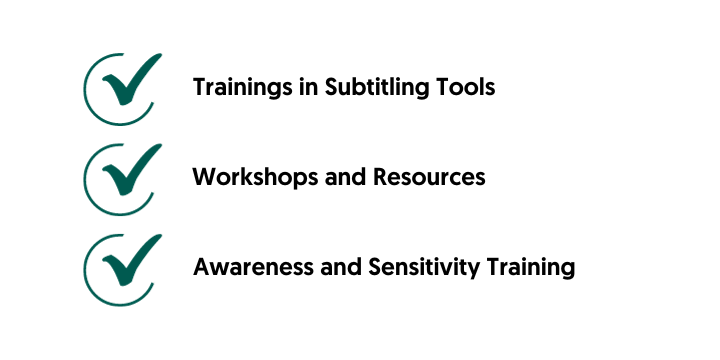Table of contents
- Subtitles in Academic Settings
- Exploring Subtitling Services: Types and Educational Use Cases
- Implementing Subtitles in University Curricula: A Step-by-Step Guide
- Technological Advancements in Subtitling
- Best Practices in Creating and Integrating Subtitles
- Educating Faculty and Staff: Training and Support
- Assessing the Impact of Subtitles on Educational Outcomes
- Navigating Challenges in Subtitle Implementation
- Amberscript: Your Partner in Enhancing Educational Accessibility
Enhancing accessibility in higher education has never been more critical, as it ensures that every student, regardless of their circumstances, can access and benefit from learning opportunities. One transformative tool in bridging this accessibility gap is the use of subtitles. Subtitles not only cater to learners with hearing impairments but also boost comprehension for non-native language speakers and enhance concentration.
- The prevalence of multi-modal learning styles makes subtitles an integral part of the education landscape.
- They reinforce auditory learning with visual reinforcement, enhancing information retention.
In this guide, we will delve into the mechanics of effectively implementing subtitles in university settings, a step toward accessible, inclusive education for all.
Subtitles in Academic Settings
The need for subtitles in academic settings reaches far beyond a simple nice-to-have add-on; it’s a crucial tool for improving access and comprehension.

According to the National Center for Education Statistics, approximately 19.4% of undergraduates reported having some form of disability in the academic year 2015–16. Among these, 11.5% reported a hearing disability. This significant portion of the student body faces added academic challenges due to their hearing disabilities, highlighting the critical role of subtitles in making course content more accessible and digestible.

Legal frameworks mandating accessibility in education: Legal frameworks like the Americans with Disabilities Act (ADA) and Section 504 of the Rehabilitation Act mandate equal access to education for all students, including those with hearing impairments. These statutes require educational institutions to provide necessary accommodations, such as subtitles, to ensure accessible learning experiences.

Broader benefits of subtitles: Beyond aiding those with hearing impairments, subtitles offer a host of benefits to a wider student population:
- Aiding non-native speakers: For students whose first language is not English, subtitles can enhance comprehension, reinforcing spoken words with text to provide a more in-depth understanding of the material.
- Catering to diverse learning styles: Subtitles cater to visual learners and reinforce auditory learning with written words, aiding information retention.
- Improving focus: For students prone to distraction, subtitles can offer an additional focus point, helping maintain concentration during lectures and multimedia presentations.
The use of subtitles in higher education is more than a mere compliance exercise. It is a transformative step towards establishing an inclusive, accessible learning environment for all students.
Exploring Subtitling Services: Types and Educational Use Cases
Subtitling services offer a diverse array of tools to enhance learning accessibility. Here we explore the different types of subtitling and their educational use cases.

- Live Captioning: Live captioning is a real-time transcription service that provides subtitles for live lectures, webinars, or discussions. This tool is vital for students with hearing impairments attending real-time classes.
- Pre-recorded Video Subtitling: This service adds subtitles to pre-recorded lectures or educational videos. Pre-recorded subtitling gives educators the chance to ensure that their content is accurately transcribed and synchronised, benefiting students with hearing impairments, non-native English speakers, and visual learners.
- Automated vs. Manual Subtitling: Automated subtitling uses speech recognition software to generate captions, while manual subtitling involves a human transcriber. Automated subtitling is faster and more cost-effective but might lack accuracy, especially in technical or specialized courses. Manual subtitling, while more time-consuming, ensures higher accuracy and context understanding.
Educational Use Cases: Successful Adoption of Subtitling
- University of Washington (UW): UW has become a leading example of the power of captioning services. They’ve implemented a robust captioning policy, mandating all publicly shared video content to have captions. This initiative, coupled with a strong commitment to accessibility, has made education at UW more inclusive.
- Massachusetts Institute of Technology (MIT): MIT’s OpenCourseWare, a web-based publication of virtually all MIT course content, has been a strong advocate of subtitling. Most of the video-based courses provide subtitles, ensuring global accessibility and comprehension.
Through these methods, universities can make significant strides towards enhancing accessibility. The implementation of subtitling is not just about compliance; it’s about providing equal opportunities for all to learn and grow.
Implementing Subtitles in University Curricula: A Step-by-Step Guide

In order to ensure an inclusive and accessible academic environment for all students, the integration of subtitles in university curricula is a vital initiative. Here’s a step-by-step guide to implementing this essential tool in your institution:
Evaluating Current Accessibility Levels at Your Institution: The first step in this process is to conduct a thorough review of your existing academic resources, investigating the level of accessibility currently available. This includes assessing the availability of subtitles in video resources, the accessibility of online platforms, and the overall ease of access to educational content for students with diverse needs.
Pinpointing Courses and Resources Ripe for Subtitling: Some courses may naturally lend themselves more towards the use of multimedia resources than others. Identifying these courses and the associated materials that are used most frequently can help determine where subtitling efforts should be concentrated. This step also involves identifying live events and classes that could benefit from real-time captioning.
Criteria for Selecting the Optimal Subtitling Service: Several factors should be considered when selecting the appropriate subtitling service for your institution. These include but are not limited to:
- Accuracy: The precision of the subtitles is critical for comprehension. This is particularly important for technical subjects where the misuse of a term can lead to misunderstanding.
- Speed: Speed is essential when it comes to live captioning. The minimal delay between the spoken words and their transcription ensures a smooth learning experience.
- Cost: Universities should weigh the cost of the subtitling service against the potential benefits it brings in terms of accessibility and inclusivity.
- Language Diversity: In our globalized world, universities host students from diverse linguistic backgrounds. Therefore, the ability of the subtitling service to accommodate different languages is a valuable feature.
Embarking on this journey towards improved accessibility is not merely about regulatory compliance; it’s a commitment to providing an equally enriching educational experience for all students. By following this guide, universities can effectively implement subtitles and contribute significantly to global education access.
Remember, there is no one-size-fits-all solution. Your institution may need to leverage a combination of services to best meet the diverse needs of your student body.

How to choose your subtitling service for precisely accurate subtitles
Read NowTechnological Advancements in Subtitling

The landscape of subtitling services has been considerably transformed by technological advancements, particularly in the realm of Artificial Intelligence (AI) and Machine Learning (ML). These cutting-edge technologies have revolutionised the efficiency and accuracy of subtitle generation, providing more reliable and precise transcription services.
- AI and Machine Learning: AI and ML algorithms can analyze spoken language and translate it into written text more accurately and swiftly than ever before. They continuously learn from their past transcription experiences, further enhancing their precision and efficiency over time. This evolution of subtitling technology is a powerful tool for increasing accessibility in higher education.
- Amberscript and Related Brands: A standout example of these advancements in the subtitling industry is the work of companies like Amberscript and its sister brands mistranscripciones.es and transkripto.de. Offering specialized solutions for educational content, these companies utilize state-of-the-art technology to provide accurate, rapid, and affordable subtitling services.
- Amberscript: Pioneering in the field of automated transcription and subtitling, Amberscript leverages AI to provide quick and precise subtitle generation. Its solutions cater to a range of formats, including lectures, webinars, and other e-learning materials.
- Mistranscripciones.es and Transkripto.de: These platforms, as part of the Amberscript group, offer services tailored to the Spanish and German markets, respectively. They maintain the same commitment to quality, accuracy, and speed, providing universities with reliable subtitling services that enhance accessibility for non-English speaking students.
The adoption and application of these advanced subtitling technologies are pivotal in breaking down barriers in education. They enable universities to offer an inclusive, accessible learning experience to all students, further contributing to global education access.
Best Practices in Creating and Integrating Subtitles
For universities to maximise the potential of subtitles as a tool for enhancing accessibility, they must adhere to a set of best practices in their creation and integration. These guidelines ensure that the subtitles produced are clear, precise, and accurate, thereby supporting the comprehension and engagement of all students.
Creating Clear and Precise Subtitles
- Accuracy: The text must precisely represent the spoken dialogue, including important details and nuances. Misrepresentations can lead to confusion and misinformation.
- Brevity: Subtitles should be succinct while capturing the essence of the spoken content. Overly long subtitles can be challenging to read within the time frame they appear on screen.
- Readability: The language used should be easily understandable. Avoid complex sentence structures and jargon wherever possible.
- Synchronization: Subtitles must coincide with the audio. This synchronisation is crucial for a seamless learning experience.
Integrating Subtitles into Educational Materials
- Inclusivity: Subtitles should be integrated into all video and audio educational materials where possible, including recorded lectures, webinars, and multimedia presentations.
- Visibility: Subtitles should be displayed in a clear, readable font and contrasting color to ensure visibility. Additionally, the positioning of subtitles should not obscure important visuals.
- Flexibility: Universities should offer the option to turn subtitles on or off, catering to the varied preferences of the student body.
Accessibility Features
- Font and Color: The choice of font and color for subtitles can greatly impact their readability. Consider using sans-serif fonts and colors that contrast strongly with the background for optimal visibility.
- Synchronization: The timing of subtitles is a crucial aspect of their effectiveness. Subtitles should closely match the audio, neither lagging too far behind nor appearing too prematurely.
- Language Support: Subtitling services should cater to the diverse linguistic needs of the global student body, offering subtitles in multiple languages where possible.
By adhering to these best practices, universities can create and integrate subtitles that enhance the accessibility and inclusivity of their curricula, contributing significantly to global education access. Remember, the goal is to foster a learning environment where all students, regardless of their abilities or linguistic background, can thrive.
Educating Faculty and Staff: Training and Support
To facilitate the implementation of subtitles and promote an inclusive learning environment, it’s crucial to invest in the training and support of faculty and staff. Educational institutions should consider the following strategies:

- Training in Subtitling Tools: Understanding the technical aspects of subtitle creation is essential for educators. Training sessions should be provided on how to use subtitling software and platforms, with hands-on demonstrations and practical exercises to ensure full comprehension. It’s a step towards equipping educators with the skills needed to create accurate and effective subtitles.
- Workshops and Resources for Subtitles Creation and Editing Skills: Alongside training in subtitle tools, workshops should be conducted to hone educators’ subtitle creation and editing skills. These interactive sessions can focus on the best practices of subtitling outlined above and provide educators with resources such as style guides and checklists to help them adhere to these guidelines.
- Awareness and Sensitivity Training: It’s essential to foster a culture of inclusivity within the university. Faculty and staff should undergo regular awareness and sensitivity training sessions that highlight the importance of subtitles as an accessibility tool. This training can help to instill a sense of responsibility and commitment towards enhancing global education access.
By educating faculty and staff, universities can create a supportive, inclusive environment that leverages subtitles to the fullest potential. Remember, the goal is not only to provide subtitles, but also to ensure they are clear, precise, and beneficial for all students.
Assessing the Impact of Subtitles on Educational Outcomes
An integral component of implementing subtitles in higher education is evaluating their impact on student engagement and achievement. Universities should consider the following techniques and approaches:
Techniques to Evaluate the Effectiveness of Subtitles in Education
- Surveys and Questionnaires: Conducting regular surveys and questionnaires among students can provide insights into their experiences with subtitled educational materials. It can reveal if the subtitles are enhancing understanding, maintaining engagement, and aiding in retention of information.
- Academic Performance Metrics: The comparison of academic performance metrics before and after the introduction of subtitles can help assess their impact. Improvements in grades, test scores, and other performance indicators can signify the effectiveness of subtitles.
Gathering Feedback from Students and Faculty
Sensitive to the benefits and challenges of using subtitles in education, students and faculty can provide invaluable feedback. Universities should consider:
- Setting up Feedback Channels: Establish channels for students and faculty to express their thoughts and experiences with subtitled content. This feedback can be used to improve the quality and integration of subtitles.
- Conducting Focus Group Discussions: Engage students and faculty in focus group discussions to delve deeper into their experiences. These discussions can provide nuanced insights into the functionality and usefulness of subtitles.
Demonstrating the Positive Influence of Subtitles on Student Engagement and Achievement
To showcase the benefits of subtitles, universities can:
- Highlight Success Stories: Share stories and testimonials of students who have benefited from subtitled content. These stories can demonstrate how subtitles can enhance the learning experience.
- Publish Impact Studies: Conduct and publish studies that illustrate the positive impact of subtitles on student engagement and achievement. Research findings can strengthen the case for adopting subtitles as a standard practice in higher education.
By assessing the impact of subtitles, universities can ensure they’re effectively enhancing accessibility and inclusivity in their classrooms, thus contributing significantly to global education access.

The Impact of Subtitles and Closed Captioning for Deaf and Hard of Hearing Viewers
Read NowNavigating Challenges in Subtitle Implementation
While subtitles can significantly enhance accessibility in higher education, implementing them can present its own set of challenges. Recognising these hurdles and adopting proactive strategies to overcome them is crucial to successful subtitle integration.
Several common issues can arise during the process of implementing subtitles in educational content, such as:
- Technical Difficulties: This could range from problems with synchronization to issues with text formatting or video-player compatibility.
- Quality Control: Ensuring the accuracy and readability of subtitles is a constant challenge, especially with complex academic topics.
- Resource Allocation: Subtitle creation and editing require time and human resources, which can be a challenge for institutions with tight budgets or limited staff.
- Language Variations: Catering to a diverse student body often means providing subtitles in multiple languages, which can be difficult to manage.
Strategies to Resolve These Issues
Confronting these challenges involves strategic planning and resource management. Universities can consider:
- Investing in Quality Subtitling Software: High-quality software can alleviate many of the technical difficulties associated with subtitle creation.
- Training and Upskilling Staff: Regular training sessions can equip staff with the skills to create and edit accurate, high-quality subtitles.
- Collaborating with Professional Subtitling Services: This can ensure quality and consistency, particularly for multilingual subtitles.
- Allocating Sufficient Resources: Implementing subtitles should be seen as an investment in education access. Allocating resources to this initiative is crucial to its success.
By anticipating these challenges and planning accordingly, universities can make the process of implementing subtitles more efficient and effective, thereby enhancing the accessibility of their educational content.
Amberscript: Your Partner in Enhancing Educational Accessibility
In the journey towards enhancing educational accessibility, Amberscript stands as a committed partner with tailored solutions for the educational sector. For universities striving to implement effective subtitling, Amberscript provides an optimal blend of technology and expertise.
Why you should use Amberscript
5x average time saving by using AI for Automatic Transcription.
Enabling an accurate flow of audio-to-data, adjustable in our easy to use online text editor. Or 100% accuracy with Human-Made Transcription.
GDPR compliant security and safety.
Tailored Solutions for the Educational Sector
Amberscript’s services are designed to simplify the process of implementing and managing subtitles. Here’s how:
- Robust Technology: Amberscript’s advanced speech-to-text technology delivers fast and accurate transcription, providing a reliable foundation for high-quality subtitles.
- Ease of Integration: Our services integrate seamlessly with a variety of digital platforms, ensuring a smooth subtitling process across diverse educational content.
- Comprehensive Support: Our team offers comprehensive support, from the initial stages of setup to ongoing management, alleviating the burden from university staff.
Benefits of Partnering with Amberscript
The value of partnering with a specialized service provider like Amberscript extends beyond just efficient subtitling. Here’s why:
- Quality Assurance: With our team of professional linguists and state-of-the-art subtitling software, we ensure the delivery of precise, readable subtitles for all your educational content.
- Time and Resource Optimization: Our services can save universities significant time and resources that can be reinvested in enhancing other aspects of education access.
- Improved Student Engagement: High-quality subtitles can enhance student engagement, comprehension, and retention, contributing to improved educational outcomes.
By partnering with Amberscript, universities can streamline their subtitle implementation, enhance the accessibility of their educational content, and thereby contribute more effectively to global education access.



